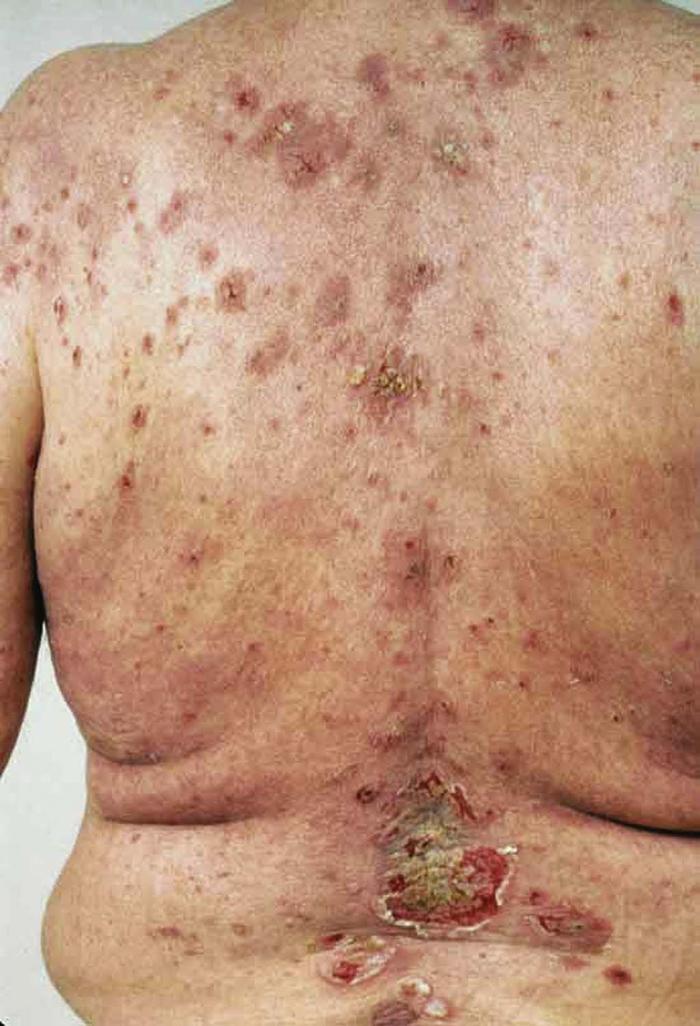Skin rashes in the elderly are typically caused by allergic reactions or exposure to irritants. Aging skin is more sensitive and prone to dryness, which can lead to itching and rashes.
Additionally, certain medical conditions and medications can also contribute to the development of skin rashes in the elderly. As a person ages, the natural protective barrier of the skin weakens, making it more susceptible to irritation and inflammation. Understanding the causes of skin rashes in the elderly is crucial in effectively managing and treating these conditions.
We will explore the common causes of skin rashes in the elderly and discuss potential treatment options.

Credit: www.griswoldhomecare.com
Common Skin Conditions
Elderly individuals can experience skin rashes due to a variety of factors, including age-related skin changes, underlying health conditions, and medications. Certain skin conditions, such as eczema and shingles, are more prevalent in older adults. Additionally, reduced immunity and slower healing processes can contribute to the development of skin rashes in the elderly.
Acute And Chronic Conditions
In the elderly, skin rashes can be caused by a variety of factors, including both acute and chronic conditions. These conditions can range from mild skin irritations to more serious and chronic skin ailments. Understanding the difference between acute and chronic conditions is important in identifying and treating the underlying causes of skin rashes in the elderly.
Acute conditions refer to skin rashes that develop suddenly and last for a short period of time. These rashes are often caused by an allergic reaction, infection, or exposure to irritants. Common examples of acute conditions include allergic contact dermatitis, insect bites, and certain types of viral infections.
Chronic conditions, on the other hand, are characterized by long-lasting skin rashes that can persist for extended periods of time, sometimes even years. These rashes are often associated with underlying health issues such as autoimmune disorders, hormonal imbalances, or chronic skin conditions. Common examples of chronic conditions include eczema, psoriasis, and rosacea.
Pruritic And Non-pruritic Rashes
Another important distinction to make when it comes to skin rashes in the elderly is whether they are pruritic or non-pruritic. Pruritic rashes are those that cause itching and can be quite uncomfortable for the individual experiencing them. Non-pruritic rashes, on the other hand, do not cause itching and tend to be less bothersome.
Pruritic rashes can be further classified as acute or chronic pruritic rashes. Acute pruritic rashes are ones that develop suddenly and cause intense itching, often due to an allergic reaction or a known irritant. Chronic pruritic rashes, on the other hand, are persistent and can be caused by underlying conditions such as eczema or chronic kidney disease.
Non-pruritic rashes, although less bothersome in terms of itching, can still be a cause for concern. These rashes are often associated with chronic conditions such as psoriasis or non-allergic contact dermatitis. While they may not cause discomfort in the form of itching, they can still affect the overall appearance and texture of the skin.
In conclusion, understanding the common skin conditions that cause rashes in the elderly is crucial in identifying the underlying causes and providing appropriate treatment. Whether the rash is acute or chronic, pruritic or non-pruritic, each type requires careful attention and consideration to ensure the well-being and comfort of the elderly individual.

Credit: www.clevelandclinicmeded.com
Age-related Skin Changes
As individuals age, skin undergoes various changes due to a range of factors such as loss of collagen and decreased oil production. These skin alterations can lead to increased susceptibility to skin rashes in the elderly.
The combination of diminished skin integrity and compromised immune system can contribute to the development of skin rashes in older individuals.
As we age, our skin undergoes several changes that make it more prone to develop rashes and other skin issues. These age-related skin changes include thinning of the skin, decreased elasticity, and reduced oil production.
Understanding these changes can provide insights into why elderly individuals are more susceptible to skin rashes.
Thinning Of The Skin
One of the prominent age-related skin changes is the thinning of the skin. This happens due to a decrease in the production of collagen and elastin, proteins responsible for maintaining the structure and integrity of the skin.
With thinner skin, elderly individuals become more susceptible to injuries and damage from external factors, leading to the development of rashes.
Thinner skin also means that blood vessels are closer to the surface, making them more susceptible to rupturing and causing bruising.
Additionally, the reduced protective fatty layer in the skin can increase the risk of moisture loss, making the skin dry and prone to irritation and rashes.
Decreased Elasticity And Oil Production
With age, the skin's elasticity diminishes, primarily due to a decrease in the production of elastin fibers and the breakdown of existing collagen fibers. This loss of elasticity makes the skin more prone to stretching, sagging, and wrinkling.
The reduced elasticity also means that the skin cannot bounce back as quickly, leading to prolonged healing periods and increased vulnerability to skin rashes. Another change in aging skin is the decreased production of sebum, the natural oil that keeps the skin moisturized and acts as a protective barrier against infection.
The decline in oil production can lead to dryness and itchiness, making the skin more vulnerable to irritants and allergens that can trigger rashes. Maintaining the skin's health and preventing rashes in the elderly requires special attention and care.
Regular moisturization, using mild and gentle skincare products, and protecting the skin from harsh environmental factors can help minimize the impact of age-related skin changes and reduce the risk of skin rashes.
Environmental Factors
Elderly individuals are particularly susceptible to skin rashes due to various environmental factors. These factors can range from irritants and allergens to exposure to the sun and harsh weather conditions. Understanding these elements can help us prevent and manage skin rashes in the elderly effectively.
Irritants And Allergens
One significant cause of skin rashes in the elderly is exposure to various irritants and allergens. These substances can provoke an allergic reaction or irritate the skin, leading to rashes. Common irritants include chemicals found in soaps, detergents, and cleaning products, while allergens can range from pollen and pet dander to certain medications.
Aged skin tends to be more delicate and vulnerable, making it more likely to react to these external triggers. Consequently, older individuals should pay extra attention to the products they use and ensure they are gentle and hypoallergenic.
Exposure To Sun And Harsh Weather
Another environmental factor that often contributes to skin rashes in the elderly is prolonged exposure to the sun and harsh weather conditions. The sun's harmful ultraviolet (UV) rays can damage the skin and trigger various skin issues, including rashes.
Similarly, extreme temperatures, strong winds, and low humidity can strip the skin of its natural moisture, leading to dryness and irritation. To protect their skin, elderly individuals should embrace sun-protective measures such as wearing long sleeves, wide-brimmed hats, and sunscreen with high SPF. Additionally, using a good moisturizer can help counteract the effects of harsh weather elements and prevent skin rashes.
Underlying Health Conditions
As we age, our bodies undergo various changes, and our skin is no exception. The elderly often experience skin rashes, which can be both discomforting and alarming. These rashes can be caused by a variety of factors, including underlying health conditions. Understanding the role of these conditions is crucial in managing and treating elderly skin rashes effectively.
Diabetes And Circulatory Issues
One common underlying health condition that can contribute to skin rashes in the elderly is diabetes. Diabetes affects the body's ability to regulate blood sugar levels, leading to a myriad of complications. Among these complications are poor circulation and neuropathy, which can impair the skin's moisture balance and ability to heal. Dry, itchy skin and slow wound healing are often observed in diabetic individuals, making them more susceptible to developing rashes.
In addition, circulatory issues, such as varicose veins and venous insufficiency, can further exacerbate the risk of skin rashes in the elderly. These conditions limit blood flow to the extremities, causing poor oxygen and nutrient supply to the skin. As a result, the skin may become dry, fragile, and prone to irritation, leading to the development of rashes.
Immunosuppression And Medication Side Effects
Besides diabetes and circulatory issues, immunosuppression and medication side effects can also play a significant role in the development of skin rashes in the elderly. As we age, our immune system may weaken, leaving us more susceptible to infections and allergic reactions. Elderly individuals with a compromised immune system are at higher risk of developing rashes due to bacterial or fungal infections.
Moreover, some medications commonly prescribed to the elderly can result in skin rashes as a side effect. Certain antibiotics, anticonvulsants, diuretics, and nonsteroidal anti-inflammatory drugs (NSAIDs) have been linked to rash development. It is crucial for healthcare providers to closely monitor medication use in older adults and adjust prescriptions as needed to minimize the risk of rashes.
In summary, understanding the underlying health conditions that contribute to skin rashes in the elderly is essential for effective management and treatment. Diabetes and circulatory issues can impact the skin's moisture balance and healing capabilities, while immunosuppression and medication side effects can increase the risk of infections and allergic reactions.
By addressing these underlying conditions, healthcare professionals can better assist the elderly in dealing with skin rashes and improving their overall quality of life.

Credit: www.hmpgloballearningnetwork.com
Frequently Asked Questions On What Causes Skin Rashes In The Elderly
What Are The Common Causes Of Skin Rashes In The Elderly?
As people age, their skin becomes thinner and more fragile. Common causes of skin rashes in the elderly include allergic reactions, skin infections, and underlying health conditions. It's important to seek medical attention to determine the exact cause and proper treatment.
How Can I Prevent Skin Rashes In Elderly Individuals?
To prevent skin rashes in the elderly, it's important to keep the skin clean and well-moisturized, avoid potential irritants, and wear breathable clothing. Additionally, identifying and addressing any underlying health issues can contribute to managing and preventing skin rashes.
When Should I Seek Medical Attention For An Elderly Person's Skin Rash?
If an elderly person develops a rash that is widespread, painful, or accompanied by other symptoms such as fever or difficulty breathing, it's important to seek medical attention promptly. Additionally, if the rash persists or worsens despite home care, a medical evaluation is recommended to determine the underlying cause.
Conclusion
To prevent and manage skin rashes in the elderly, it is crucial to identify and address their underlying causes. By maintaining good hygiene, keeping the skin moisturized, and avoiding triggers such as harsh chemicals and allergens, we can help reduce the risk of skin rashes.
Regular medical check-ups and prompt treatment of any related health conditions are also essential. Remember, taking care of the skin is an integral part of overall well-being for our senior loved ones.






0 Comments